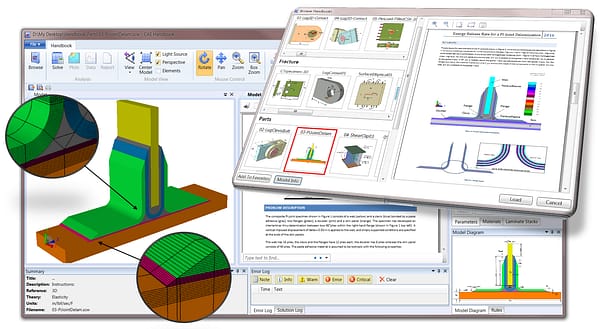Smart Engineering Simulation Apps (SESA or Sim Apps) are a revolutionary breakthrough in the ability to standardize and automate recurring analysis tasks and simulation workflows, using FEA as a solver engine.
Smart Engineering Simulation Apps
ESRD’s numerical simulation technology, and simulation tools like CAE Handbook built upon this technology, are an ideal fit for engineering leaders, authors and users of Sim Apps. Let’s learn why…
Schedule a Sim App Demo
Would you like a no-cost demonstration of our simulation application and automated workflow solutions? Complete our Request an Engineering Application Demo form and we will get back to you shortly.

Sim Apps are finite element analysis (FEA)-based CAE software tools that standardize and automate recurring analysis tasks and simulation workflows.
Sim Apps are designed to fit into existing or reimagined processes that capture design rules, best practices, and institutional knowledge of the user’s organization and industry while encapsulating complexity and technical risk.
Sim Apps are created by experienced simulation analysts for designers and engineers who may not have the expertise required to efficiently or reliably perform FEA. Sim Apps are “smart” if they satisfy the requirement of Simulation Governance and automatically provide users of any experience level with an explicit measurement of analytical quality through solution verification. To understand the role of Simulation Governance in accelerating the adoption of Sim Apps read this Comet Solutions blog article by ESRD President and CEO Dr. Ricardo Actis.
Of the nearly 2 million engineers in the US, with over 250,000 mechanical engineers and designers, it is estimated that about 10% of those are routinely using simulation software.
Far fewer of these would be considered expert simulation specialists. The use of Sim Apps enables simulation-driven design and the democratization of simulation by allowing many more designers and engineers to routinely access the value of simulation technologies with confidence and reliability.
For the simulation specialist, Sim Apps make difficult classes of problems easier, faster, and more accurate to tackle to support the ever-increasing performance and complexity of products including their design, manufacture, test, use, and repair. Sim Apps makes routine design analysis decisions solvable by the designer / engineer as they once did when using conventional handbooks or design curves for less challenging designs. Sim Apps empowers the new engineer or project team member to be productive sooner with access to reliable tools that have captured the institutional knowledge, standards, and best practices of their organization.
Existing simulation technologies based on traditional finite element implementations are problematic when used as the “engine” behind Sim Apps.
The numerous reasons that traditional FEA software is not used routinely by design engineers are the same obstacles that make them largely unsuitable for use in Sim Apps. The inherent complexity and expertise required to ensure that modeling assumptions, meshing rules, element selection and extraction of results are consistent, combined with the inability to measure or control solution quality, is often an insurmountable challenge for production use. To learn more why this is so, download the NAFEMS America 2016 paper by ESRD and view the NAFEMS webinar on “Simulation Governance: Technical Requirements”.
From a business perspective, given the amount of effort to create a traditional finite element model that is simple and robust enough for casting into a Sim App, then post-processing results with confidence, it is no surprise that the financial ROI is often weak. Fortunately, a new generation of numerical simulation technology is now available which has proven to be far easier and more reliable to use for powering Smart Sim Apps.
ESRD’s numerical simulation technology base allows the creation of Sim Apps that are far more simple, efficient, robust, and reliable to create and use when compared to those created on-top of legacy finite element software.
The implementation is based on a hierarchic modeling framework and hierarchic finite elements spaces with an extremely simple element library enabling the same mesh to support all analyses types. High resolution solutions are obtained from low density meshes and an unmatched post-processing capability provides objective measures of solution quality for any function of interest, anywhere in the model, and at anytime.
Only finite element implementations designed to support verification and validation procedures can enable the practice of Simulation Governance required for Smart Sim Apps. Otherwise, to pretend to hide the complexities of finite element meshing without providing the non-expert user with an explicit measurement of solution quality is reckless. To learn more why this is so download the new ESRD whitepaper “Technical Requirements of Smart Engineering Sim Apps”.
ESRD has been creating custom Sim Apps, like this one for 3D crack simulation, through contracts with the Aerospace & Defense industry for well over a decade.
Many customers have gone on to create their own custom scripts or deployable Sim Apps that are now being used daily across their organizations in support of new products as well as existing programs. The problem classes include detail stress analysis, composite materials analysis, fracture mechanics, residual stresses, fastener joints, and global/local analysis of large structures. Below is a sample fracture mechanics application Sim App:
Check out the below links for ESRD’s “Smart Engineering Simulation Apps” blog article for an EnginSoft newsletter as well as examples of industry-specific Sim Apps as deployed in ESRD’s solutions portfolio:
- Deployment of Smart Simulation Apps in Support of DaDT Activities (PDF)
- Smart Sim Apps Demo: Laminated Composite Joint Analysis (Video)
- Crack Propagation Analysis Tool for 3D Crack Simulation: A Simulation App Case Study (PDF)
- Smart Engineering Simulation Apps Blog Article (EnginSoft)
- CAE Handbook powered by StressCheck (PDF)
- Single Fastener Analysis Tool (SFAT) (PDF)
- Multi-Fastener Analysis Tool (MFAT) (PDF)
- Laminated Cutout Analysis Tool (LCAT) (PDF)
Request a Sim App Demo
Would you like to learn more about developing your own Sim Apps, or to consult with ESRD on the development of a customized Sim App? Schedule a Sim App demo with us by completing the below form and we’ll contact you as soon as possible.
Looking for Resources?
Recent News & Events
Quick Links
Testimonials
-
“We have been having very good success using the P-Version finite element code, StressCheck, to develop the 2-D solutions for two independent cracks in a plate. I have asked one of our AFGROW team members to model the plate and lug cases using StressCheck and compare them to the existing AFGROW closed-form solutions. [He] modeled the cases several different ways to be sure that he was getting the best possible solutions. He has verified that the bearing load option in StressCheck provides excellent results.”
 Serving the Numerical Simulation community since 1989
Serving the Numerical Simulation community since 1989 





